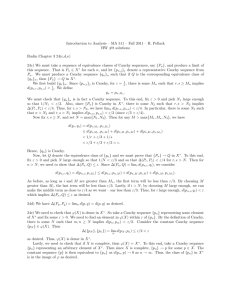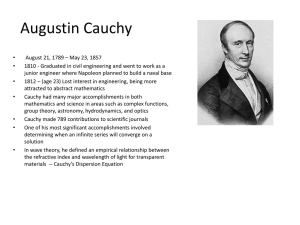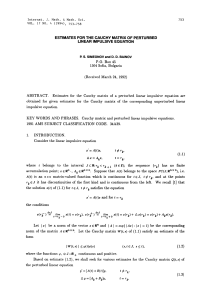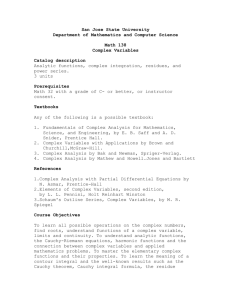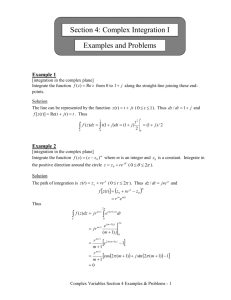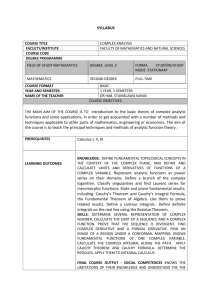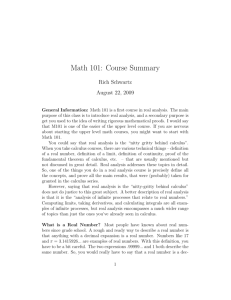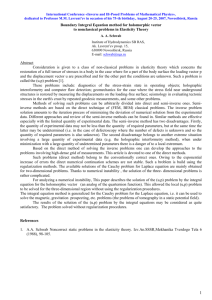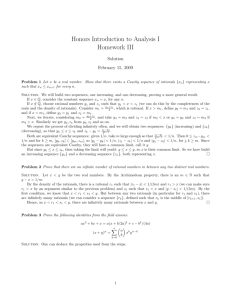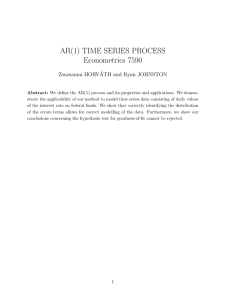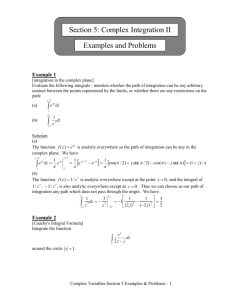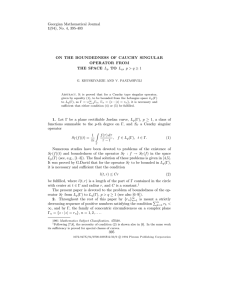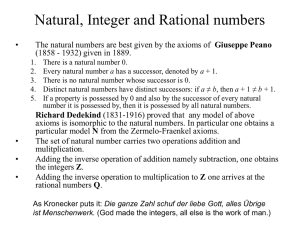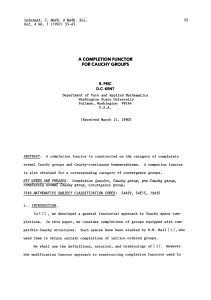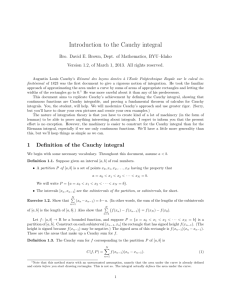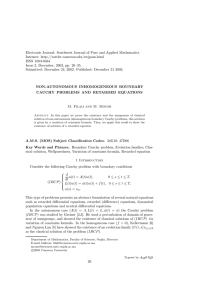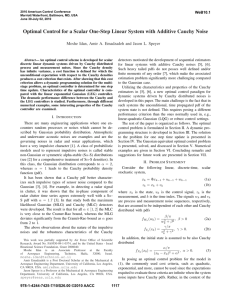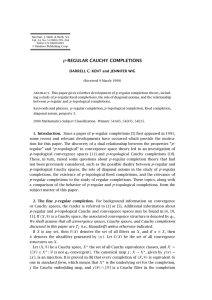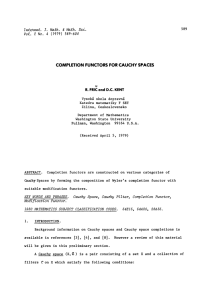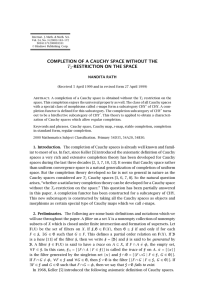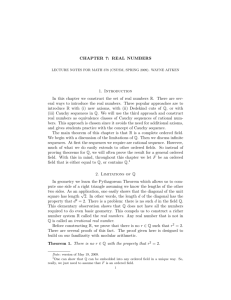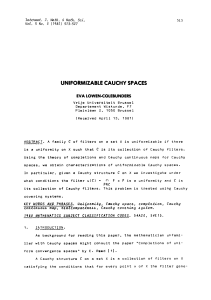THE CAUCHY RANDOM VARIABLE p p p p p p p p p p p p p p p p p
advertisement
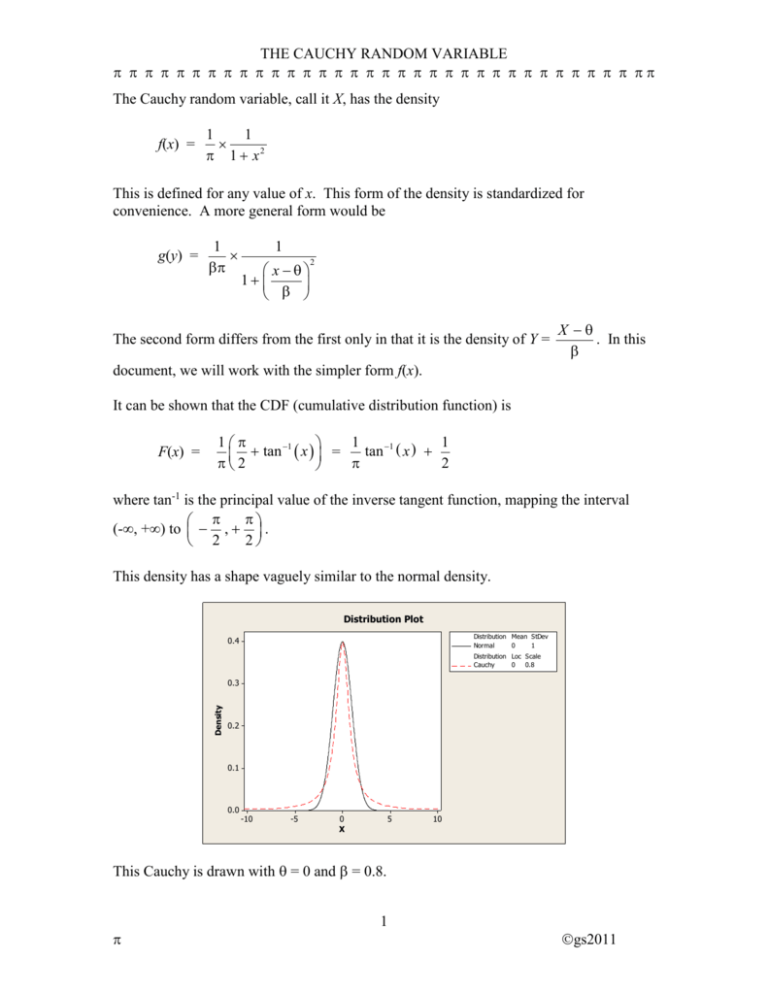
THE CAUCHY RANDOM VARIABLE The Cauchy random variable, call it X, has the density f(x) = 1 1 1 x2 This is defined for any value of x. This form of the density is standardized for convenience. A more general form would be g(y) = 1 1 x 1 2 The second form differs from the first only in that it is the density of Y = X . In this document, we will work with the simpler form f(x). It can be shown that the CDF (cumulative distribution function) is F(x) = 1 1 1 1 tan 1 x tan x = 2 2 where tan-1 is the principal value of the inverse tangent function, mapping the interval (-∞, +∞) to , . 2 2 This density has a shape vaguely similar to the normal density. Distribution Plot Distribution Mean StDev Normal 0 1 0.4 Distribution Loc Scale Cauchy 0 0.8 Density 0.3 0.2 0.1 0.0 -10 -5 0 X 5 10 This Cauchy is drawn with = 0 and = 0.8. 1 gs2011 THE CAUCHY RANDOM VARIABLE The first important observation about this random variable is that its expectation (meaning expected value, E X , does not exist. If we tried to compute the expectation, we would go through the following steps: EX = 0 x 1 1 1 x 1 x dx = dx dx 2 2 1 x 1 x 0 1 x2 u 1 x2 = du 2 x dx 1 1 du u 1 1 du 1 = u 1 du u 1 1 du u In this final form, the first integral is -∞ and the second integral is +∞. A difference of the form -∞ + ∞ is undefined. Thus, we conclude that the expected value of the Cauchy random variable does not exist. A few notes about this derivation: * We might have claimed to be doing an integral in which the integrand is odd, meaning w(-t) = -w(t). Such an integral, it might seem, must have the value 0. However, in order to claim the value of zero, we must have the condition M w t dt for every value M, including M = ∞. This fails for our M case at M = ∞. (The proper method of evaluation requires breaking the integral into positive and negative pieces, as was done above.) * “E(X) does not exist” should be distinguished from the condition “E(X) = ∞.” 1 I x 1 will have The random variable W with density h(w) = 1 x2 E(W) = ∞. Simulations of the random variable W will have running averages that tend to infinity. Running averages of a Cauchy random variable, as illustrated later, will drift aimlessly. * Once we have shown that E(X) does not exist or E(X) = -∞ or E(X) = ∞, then we know that there are no finite higher moments. Specifically, we cannot have E(X r) finite for any positive integer r. * Since X does not possess finite moments, it does not have a moment generating function. 2 gs2011 THE CAUCHY RANDOM VARIABLE A fascinating property of the Cauchy distribution is that the average of a sample of n has the same probability law as a single observation. That is, the density f(x) given at the start of this document is also the density of the average of a sample of n. This fact can be proved easily using characteristic functions (the complex version of moment generating functions) but will not be shown here. As a consequence, sample averages do not collapse to a single number, and do not furnish consistent estimates. You might find it reassuring to learn that the sample median still converges to the population median. It is insightful to examine simulations of Cauchy random variables. The following is a list of 100 random observations from the density f(x) : -1.5139 0.4686 0.3985 -3.5293 -2.1019 0.1694 1.2675 -2.7102 0.9599 10.2059 -2.4118 0.3133 -6.4196 -11.4843 -0.8738 -0.1901 3.9489 -0.1446 -2.6524 1.2915 -0.0614 -1.4026 2.3671 1.4377 1.4793 -0.6400 -0.2560 0.6219 3.4551 -2.1849 2.2586 2.6193 2.9390 0.3730 -0.3682 0.8196 -0.1441 291.7397 -0.7430 -6.6128 0.1553 0.8182 -0.3996 -0.5949 -0.4358 0.0470 -0.1018 2.4523 0.1112 1.8216 -0.8731 -0.4082 0.1632 -0.0193 -0.1475 0.5198 0.0284 0.0473 7.6080 0.6423 -8.1156 -0.6224 0.2975 2.1273 0.0497 -2.8737 1.9368 0.0579 0.0313 -0.1037 25.8341 0.6676 -0.0265 -0.6947 -0.4496 -2.6795 1.2335 10.6785 -32.0676 0.0801 1.0851 0.4534 -0.1583 -1.9968 -0.6431 6.8516 1.3233 -0.0990 0.1500 5.3366 -5.4889 -0.9753 0.8004 -2.5827 0.9441 1.5133 -0.1499 3.0644 0.5446 0.0588 Please be advised that not all Cauchy samples look bizarre. Small samples, say the first eight values down the first column above, could easily pass for normal data. 3 gs2011 THE CAUCHY RANDOM VARIABLE Here is a plot of the running average: Running Average 7.5 5.0 2.5 0.0 1 10 20 30 40 50 Index 60 70 80 90 100 The sequencing here is 1-20 (first column above), 21-40 (second column above), and so on. This is a fairly typical Cauchy running average plot. 4 gs2011
